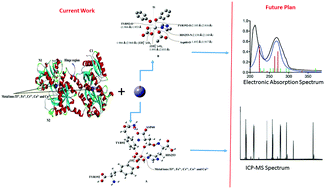Theoretical insights into the competitive metal bioaffinity of lactoferrin as a metal ion carrier: a DFT study†
Abstract
Metal–protein complexes, specifically lactoferrin (Lf), an iron-binding glycoprotein found naturally in milk and several other body fluids play a pivotal role in all living organisms. Due to the involvement of these metalloproteins in health-related studies, a deeper understanding of the metal ion bio-affinities in the metal binding pocket would be of significant research interest. Accordingly, the broader goals of this study are to assess the competitiveness of the biological metal binding bio-affinities found in microfluidics. This study is therefore aimed at an extensive exploration of the recognition of individual biological metal ions and their interactions with the metal ligating residues of Lf (TYR92, TYR192, HIS253, ASP60, and CO32−) in a vacuum and in implicit and explicit aqueous solution at physiological pH. Density functional theory (DFT) with the B3LYP functional was used to identify effective electronic factors that potentially contribute to the extent of the metal ion bioaffinities. The LANL2DZ basis set was used for Ti4+, Fe3+, Cr3+, Co2+, and Cu2+ and the 6-31+G* basis set was applied for the rest of the atoms. The metal ion binding energies in a vacuum and in implicit and explicit aqueous media together with ΔEHOMO–LUMO chemical hardness (η) and softness (S) revealed the strongest metal affinity for Ti4+ in comparison with others. The observed trends for metal affinity follow the order Ti4+ > Fe3+ > Cr3+ > Co2+ > Cu2+, which is supported by the reported experimental binding constant values (log kbinding) along with ICP-mass spectroscopy in the literature. The stabilization energies derived using the second order perturbation theory, E(2), of NBO analysis confirmed the greater charge transfer for the observed trends in the metal binding. Furthermore, the observed metal binding energies in the explicit solvation model (ΔEexplicit) with six water molecules coordinated to the metal ions in the octahedral system highlight the importance of the hydration of free metal ions in the metal binding process. The findings of this study identify efficient electronic factors as major contributors to the metal binding affinities, with promising possibilities for the design of metalloproteins and sensing of the metal ions.



 Please wait while we load your content...
Please wait while we load your content...